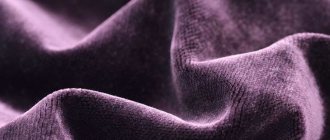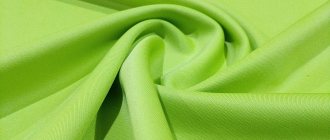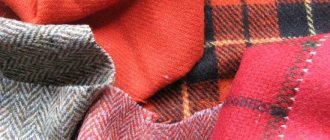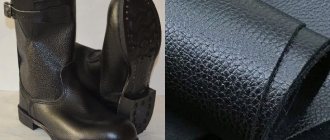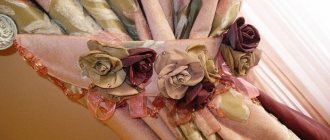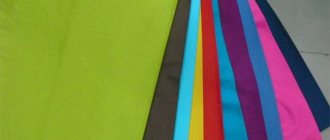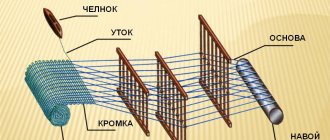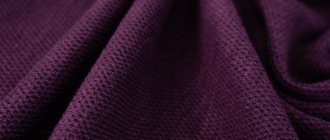In houses and apartments, not only curtains of various shades are hung on the windows, but also light, airy tulle. To make them, manufacturers use organza, veil, and mesh. The modern market is rich in various fabrics, so they are divided into categories: matte, sparkling, patterned, plain.
You can choose the right tulle for your interior using the advice of experienced professionals. A well-chosen curtain for each room will create a cozy atmosphere. To understand which tulle is better: veil, organza or mesh, you should study the features and properties of each.
Veil - what is it?
What is a veil
The veil is a rare woven material that belongs to the category of elite. This word is often associated with a bride in her wedding dress. However, several centuries ago, things were also made from this material for men.
It is created by a plain weave and is a bit like thick gauze. The usual raw material for veils is cotton, although silk and wool fabrics are known. Today, modern products of synthetic composition that contain polyester fibers are also popular.
History of appearance
Many housewives, before purchasing curtains for their home, wonder what a veil is. This word literally means “blanket” when translated from French. Several decades ago, headdresses were made from veils, which were mainly worn by married women.
How did this type of material appear?
The weighted material was intended for widows or nuns. Depending on the color, several types of fabric were distinguished. These hats were used on the road or on the street, not wanting to be recognized. A little later, the veil served as decoration as a detail for a woman’s hat.
To sew a veil product, a rare translucent fabric was used, which was woven from cotton, linen, silk or wool.
Important! Today the luxury brand Chanel produces clothes, shoes, and accessories from this material.
Production technology and characteristics
Bleached, plain-dyed or printed types of veils are available on the modern market. It can be purchased in various colors in online stores. As a rule, the usual colors include delicate, pastel tones, which are most often used in the kitchen.
You might be interested in this: Special characteristics and use of satin ribbons
Note! The production of quality products consists of a complex technological process. In practice, various methods are used that lead to the creation of this beautiful fabric.
The prices for such products are generally high. The veil is durable and reliable. With proper care it will last a long time.
What technology is used to make the fabric?
Application
The veil is ideal for creating window curtains and airy curtain elements. The fabric is irreplaceable when sewing both formal and everyday women's outfits. The veil is especially often used in the manufacture of wedding dresses and clothes in a romantic style. The material is also used to create individual elements of outfits: all kinds of draperies, decorative flowers, translucent inserts.
Types and types of voile curtains
Various products are made from several types of tulle:
- a simple rectangular curtain that hangs loosely on the floor, forming folds. Models are being developed in one layer, two or more, which create additional volume;
- a lambrequin is a curtain that is thrown over a cornice rod;
- crossed from two canvases are produced in the form of a large rectangle. Long or short canvases are assembled from various accessories;
- Italian curtain. The canvas is collected from the top of the cornice, and then simply thrown over it or passed through with the help of a decorative ring, which acts as a weighting agent;
- The French curtain has symmetrical flounces. If desired, you can freely change the height of the French curtains. The shuttlecocks must be preserved even with the maximum lowering of the canvas.
Type of fabric
Similarities and differences with other thin materials
Organza is a dense fabric that consists of silk and polyester. It can be distinguished by its lightness, airiness and elasticity. Many housewives prefer to buy this material, as it is very easy to wash. The main thing is that it does not lose its attractive appearance over time. She is not afraid of dust and sun.
Voile is a fabric that goes well with different curtains. Thanks to its unique properties, it does not fade in the sun. When the slightest defect occurs, the tulle loses its appearance, even if there is a slight snag. It is almost impossible to correct the defect.
Distinctive properties
Note! Experts recommend not buying organza if there are children or pets in the house.
The difference between organza and veil is that the second material goes well with kitchen windows, hallways, and living rooms. The second look gives the room a more festive look. The veil is most often hung in living rooms. Organza is less breathable due to the density of its structure.
Fabric characteristics
Voile is a rare woven mesh fabric produced by plain weave. It is usually made from cotton, but sometimes the base for the veil can be silk or wool. Sometimes synthetic fibers based on polyester are used for manufacturing. From a lexical point of view, veil is a word derived from the French “voile”. It is translated into Russian as veil or haze.
Buyers often confuse veil, chiffon and organza with each other. The first two fabrics have a soft, flowing texture, a non-shiny surface, and a weave of threads that provides a light structure to the fabric. They are mobile, weightless, translucent. The veil is characterized by greater durability and has a high density of thread weave. This makes it suitable for tulle production. Compared to organza, it is characterized by increased softness and a pronounced matte surface.
The veil found on store shelves is most often monochromatic. Its color can be varied. Sometimes one color is diluted with lace or prints. There are also other visual effects. Thus, after treating the canvas with reagents, it is possible to obtain translucent images. Curtains based on a veil are often decorated with:
- drawings;
- sequins;
- rhinestones;
- border;
- lace;
- embroidery;
- flock.
Areas of use
The material is quite soft with a matte surface and translucent structure. Thin and also exquisite draperies look very beautiful. The veil is especially suitable for products such as:
- curtains, curtains and other types of light home textiles;
- an elegant women's dress that looks perfect on a hot, sultry day, as the fabric is breathable;
- wedding outfit. Today, numerous salons offer a variety of products. Sometimes it is difficult for a bride to make a choice;
- An interesting decorative element of clothing.
You might be interested in what coarse fabrics exist, their properties and uses
Where is this type of material used?
The description of the voile fabric for curtains says that it has good breathability. It is quite simple to sew, but the edges should be properly processed, for example, with a special braid. The material is easy to wash, but you need to pay special attention to the cotton veil, as it can shrink.
Scope of application
The main areas of application are:
- Sewing veils and wedding dresses (in this case, a linen veil can be used; you can find out about the properties of linen fabric in another article). In recent years, this has been the main area of use, which is relevant for many countries around the world.
- Modern designers also use it to decorate interiors of different styles (from classic to modern). It can play the role of a separate decorative element (drapery, wall decoration, etc.), or be part of an entire composition.
- In the photo of voile fabric from the Internet you can also see that it is used today to create suspended ceiling systems. This solution is relevant for light, free, sunny interiors. At the same time, all the design with its help can be done with your own hands, without the involvement of designers, because it is extremely easy to use.
Tips for caring for curtains
When purchasing a delicate translucent product, you should first study the description of the fabric composition and the recommended washing mode. Like all delicate items, it is best to wash the veil by hand.
Note! Experienced housewives say that curtains should be soaked for 2 hours before washing. To do this, you need to use a mild detergent. In order not to spoil the product, you need to prepare a cold solution.
Rubbing and twisting the material is not recommended. Sometimes stains appear on the canvas. They need to be removed before washing. There are many delicate laundry detergents sold today. For a synthetic veil, you need to choose a gentle mode. As a rule, it is not recommended to wring fabric either in a machine or by hand.
Care instructions
The washed product must be spread horizontally and allowed to drain, after which it remains to be carefully straightened and hung to dry. The material should be ironed from the wrong side.
Important! If a product made from a veil needs to be put away for storage, then it is better not to fold it, but to roll it up.
Care
Many people, when first encountering voile products, do not know how to wash, iron, and dry delicate items. Maintenance is simple, but if you do not follow simple rules, you can permanently damage the fabric.
The material is not washable in a washing machine: it can become deformed under active mechanical influence. That is why the products are washed by hand, soaking in a soap solution at a temperature of 35-40°C. White veil items that have yellowed with time lend themselves well to bleaching at home. You just need special delicate bleaches without chlorine. Products intended for children's clothing are suitable. They also bleach in warm water, after soaking for 1-2 hours.
Dry naturally, horizontally. You cannot squeeze the product by twisting the material: it will become deformed. It is better to let the water drain and then lay the fabric out to dry. Ironing is usually gentle, using a steamer. Experienced housewives advise first trying to iron a similar material to check whether it will deteriorate.
Voile fabrics fray easily. If the edge begins to unravel, it must be carefully hemmed, turning it inward. Care is not complicated, but it has some peculiarities. By following the rules, you will maintain the presentation of the product for a long time.
Dear readers of the Tkan.Club website, if you still have questions on this topic, we will be happy to answer them. Leave your reviews, comments, share stories if you have dealt with this fabric! Your life experience may be useful to other readers.
Advantages and disadvantages
When choosing a product for the interior, you need to pay attention to the color scheme. At the buyer's request, many manufacturers can model one curtain or make a set of two. For children's and teenagers' rooms, you can choose canvases with several colors or original patterns.
The main advantage of tulle is that it is too light. This facilitates the penetration of sunlight.
The main drawback is that dust quickly collects on it. If household members are prone to allergies, then it is better to refrain from purchasing fabric.
Advantages and disadvantages
Veils for men
Many people believe that the veil is an item of exclusively female clothing, but this is a misconception. Thus, among some African peoples (Tuareg, Songhai, etc.) men use a veil to protect themselves from evil spirits, and they do not take it off even in front of their family members.
In Pakistan, India, Nepal and Bangladesh, men wear a special veil - sehra - on their wedding day. It is attached to the turban (pagdi), and consists of long flower garlands or strings with beads covering the groom's face.
What is tulle?
Tulle is a generic concept that applies to various categories of sheer curtains. It is made from polyester and other materials with the addition of other threads. The result is fabrics of varying textures, densities and strengths.
Here are the main types of tulle that are used in the production of curtains:
- Cotton tulle. It is obtained by adding cotton threads. As for texture, the canvas can be smooth or with a printed pattern. Curtains create a feeling of lightness in the room, since the fabric has properties such as breathability and weightlessness.
- Silk tulle. It is not easy to find this type of fabric in stores, since it is rarely put on mass sale. And this is due to its high cost. After all, the material is made with the addition of natural silk threads, which significantly increases the price of the product. As for the physical characteristics, this fabric is distinguished by its smoothness, shine and flowing texture.
- Wool tulle. Fabric made with the addition of wool thread is highly expensive and belongs to the luxury category. It will be an excellent solution for a room where the windows receive sunlight most of the day. Indeed, in hot weather, this material will inhibit the passage of ultraviolet radiation into the room.
What are the differences between tulle and veil? There is no difference, since the veil is a type of tulle. There are many types of transparent fabrics that differ from each other in weaving, color, and composition. Which to choose? The answer to this question depends on the individual preferences of the buyer. (
Hat with veil
In the Middle Ages, women and girls began to hide their faces under a veil on a hat. It was a refined tradition. In the fashion of the 19th century, women and girls had a top hat with a veil, intended for riding. The men tried to look under the stranger’s veil, thereby recognizing her mystery. But the woman had to present a secret with all her behavior.
This look was perfect when a translucent mesh was placed over the face. Until now, to add mystery to her appearance, a girl can wear a hat with a veil slightly to one side and on her forehead. But this headdress is not very suitable for everyday wear. He is too pompous, too conspicuous. But wedding hats with a veil can easily replace the traditional veil.
Now it is generally clear what a veil is.
